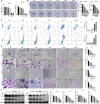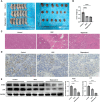The mechanism of Shancigu and its monomer in the development of colorectal cancer based on network pharmacology
- PMID: 40603959
- PMCID: PMC12222874
- DOI: 10.1038/s41598-025-04795-7
The mechanism of Shancigu and its monomer in the development of colorectal cancer based on network pharmacology
Abstract
Shancigu has traditionally been used for clearing heat, detoxification, resolving phlegm, and dissipating masses. However, its potential mechanisms in colorectal cancer (CRC) remain unclear. This study aimed to explore the molecular mechanisms of Shancigu and its active compound in CRC. The active ingredients of Shancigu and their predicted targets were identified, and differentially expressed genes (DEGs) associated with CRC metastasis and invasion were screened. Intersection genes were obtained and used to construct a protein-protein interaction (PPI) network. Core genes were identified, and their prognostic significance was analyzed. Molecular docking was performed between key survival-related genes and Shancigu compounds. Further in vitro, organoid, and in vivo experiments were conducted to investigate the regulatory effects of Stigmasterol, a major active component. A total of 18 active ingredients and 366 potential targets of Shancigu were identified. From 19,331 DEGs, 365 intersection genes and 18 core genes were screened. Among them, AKT1, AR, FN1, HRAS, ITGB1, and JUN showed significant prognostic relevance in CRC. Molecular docking revealed that Stigmasterol strongly binds to ITGB1 and JUN. In cellular experiments, Stigmasterol inhibited viability, proliferation, migration, and invasion, induced apoptosis, and downregulated JUN and ITGB1 expressions in HCT116 and Caco-2 cells. In CRC organoids, Stigmasterol reduced organoid viability and ATP activity. Animal studies demonstrated that both Shancigu and Stigmasterol reduced tumor weight and volume and inhibited Ki67, ITGB1, and JUN expression. Stigmasterol may suppress CRC proliferation and invasion by targeting the key genes JUN and ITGB1, providing insights into the potential therapeutic mechanisms of Shancigu against CRC.
Keywords: Colorectal cancer; ITGB1; JUN; Network pharmacology; Shancigu; Stigmasterol.
© 2025. The Author(s).
Conflict of interest statement
Declarations. Competing interests: The authors declare no competing interests. Ethics approval: For human samples, all procedures performed in studies involving human participants were in accordance with the ethical standards of the institutional and/or national research committee and with the 1964 Helsinki Declaration and its later amendments or comparable ethical standards. The study was approved by the Medical Ethics Committee of Foshan Fosun Chanchen Hosipital (Approval Number CYEC-LCYJ-2024081-PJ-20240926). For animal experiments, all methods were carried out in accordance with relevant guidelines and regulations. All animal procedures were approved by Animal Ethics Committee of Guangzhou Forevergen Medical Laboratory Animal Center (Approval number IACUC-AEWC-F2309001). Animal experiments were performed in accordance with ARRIVE guidelines, IACUC Handbook (third edition) and American Veterinary Medical Association (AVMA) Guidelines for the Euthanasia of Animals (2020). Informed consent: Written informed consent was obtained from all individual participants included in the study. Consent to publish: Not applicable.
Figures








Similar articles
-
Network Pharmacology Analysis and In Vitro Validation of the Active Ingredients and Potential Mechanisms of Gynostemma Pentaphyllum Against Esophageal Cancer.Comb Chem High Throughput Screen. 2025;28(3):500-513. doi: 10.2174/0113862073280183240108113853. Comb Chem High Throughput Screen. 2025. PMID: 38243957 Free PMC article.
-
Exploring the Molecular Targets and Therapeutic Potential of Coptisine in Colon Cancer: A Network Pharmacology Approach.Curr Med Chem. 2025;32(16):3295-3308. doi: 10.2174/0109298673262553231227075800. Curr Med Chem. 2025. PMID: 38231070
-
Exploring the mechanism of feiyanning formula and its extract apigenin against EGFR-TKIs resistance in non-small cell lung cancer based on UPLC-HRMS and experimental validation.J Ethnopharmacol. 2025 Jul 24;351:120120. doi: 10.1016/j.jep.2025.120120. Epub 2025 Jun 9. J Ethnopharmacol. 2025. PMID: 40499802
-
Study on the mechanism of Shujin Tongluo granules in treating cervical spondylosis based on network pharmacology and molecular docking.Medicine (Baltimore). 2023 Jul 21;102(29):e34030. doi: 10.1097/MD.0000000000034030. Medicine (Baltimore). 2023. PMID: 37478234 Free PMC article.
-
Evidence construction of Huangkui capsule against chronic glomerulonephritis: A systematic review and network pharmacology.Phytomedicine. 2022 Jul 20;102:154189. doi: 10.1016/j.phymed.2022.154189. Epub 2022 May 20. Phytomedicine. 2022. PMID: 35617887
References
-
- Liu, J. et al. miR-330-5p suppress cell growth and invasion via disrupting HSF4-mediated MACC1/STAT3 pathway in colorectal cancer. FBLront. Biosci. (Landmark Ed), 29(2). 53-64 (2024). - PubMed
-
- Fu, Z. et al. CELF6 as an oncogene in colorectal cancer: targeting stem-cell-like properties through modulation of HOXA5 mRNA stability. Front. Biosci. (Landmark Ed). 29 (11), 395-408 (2024). - PubMed
MeSH terms
Substances
Grants and funding
LinkOut - more resources
Full Text Sources
Medical
Research Materials
Miscellaneous

